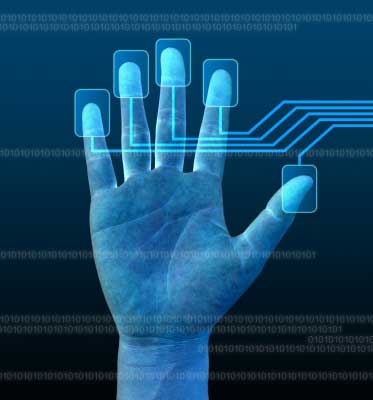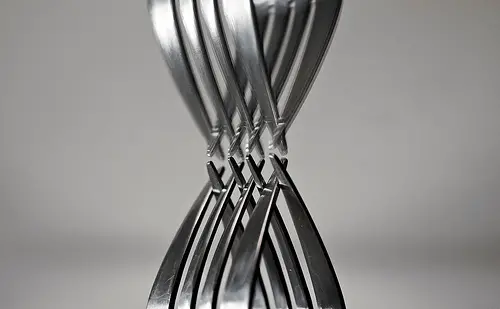
Photo by [twobee] FreeDigitalPhotos.net
This all started back in July of 1892 by a man in La Plata, Argentina, he was a member of the police force there. We’ll refer to him as Inspector Alvarez for the sake of this post.
Alvarez was sent to Necochea in order to aid in the investigation of a brutal murder of two children who had been battered to death while they slept. They lived there with their 26 year old mother Francisca Rojas and she was considered the likely suspect for the crime. The only problem was, they couldn’t force a confession from her and they really had no other supporting evidence to her committing the crime.
A Fingerprint in Blood
Upon arriving at the scene of the crime, Alvarez began his search of the shack they lived in. While digging for clues he stumbled upon a bloody fingerprint on the door. It appeared to be a print of someone’s thumb.
So Alvarez took a saw and removed the portion of the door that contained the thumbprint and carried it down to the police station for further examination. After which he sent for Francisca and had her fingerprinted to make a comparison.
Once Francisca learned that the fingerprint they took from her matched the one recovered from the door, she began singing like a bird. For those of you that don’t understand that, basically she began confessing to the crime.
Of course having her confession, there wasn’t much left to the case, it was closed and she was convicted of the horrible murders. Alvarez then became the first detective in history to ever solve a murder case by using a fingerprint.
Although this was a crude method, it worked beautifully in gaining a conviction in court.
Where Did Alvarez Learn of Fingerprints
So if this technique had never been used before, you’re probably wondering, how did Alvarez know to use the fingerprint in his investigation.
He had studied the work of a man named Juan Vucetich, a colleague of his from the bureau of statistics for the La Plata police. Vucetich’s work of using this method to analyze and classify fingerprints was something Alvarez had been following but never had the opportunity to put to work until the Necochea murders.
Vucetich’s method made it both easy to file and retrieve fingerprints and up until Alvarez’s case, his work had pretty much been ignored by law enforcement. But of course since the successful conviction of Francisca, Argentina police adopted fingerprinting as it’s main method for identifying criminals, in fact, they were the very first country to adopt this method of identification.
When Did Fingerprints Really Begin
Even though fingerprinting wasn’t fully adopted within a law enforcement agency until the late 1800s to early 1900s by Argentina, it had been discovered much earlier by a man named William Herschel in 1858. Herschel was a British civil servant who worked in India.
The way it all started was in the signing of a contract by someone that couldn’t read or write. Herschel had a local builder in India sign a contract with a palm print of his entire hand, because the man didn’t know how to sign his own name.
After receiving the palm print, Herschel noticed the uniqueness of the lines in the print. Being fascinated with this, he began collecting fingerprints of everyone he came into contact with. This allowed him to discover that every fingerprint was unique and after many years of collecting them, he also discovered that the prints remained the same throughout a person’s lifetime.
Using the work of Dr. Henry Faulds in 1880, Herschel later discovered that a fingerprint actually didn’t need ink to show up. Faulds’ work stated that the sweat and oils on the hands and fingertips was all you needed for a fingerprint to make an impression on a flat surface.
The Final Steps in Identification
It wasn’t until 1896 that a man named Edward Henry developed a classification system for identification of fingerprints. Henry divided fingerprint patterns up into five different sections. They were: Plain Arches, Tented Arches, Ulnar Loops, Radial Loops, and Whorls.
These different types of fingerprints adopted a code system of A, T, U, R, and W. Then he took it a step further by counting the amount of lines that were in a print. These were used to create a map of the triangle positions that formed where the lines were divided.
His formula for identification not only made the system easy for someone else to learn, but also made the filing and retrieval process quite rapid. In mere minutes, any fingerprint could be located.
Henry’s system became so successful that during the next few years, police all over Europe and North America adopted it and began using fingerprinting in all criminal cases. But the United States pulled up the rear by adopting fingerprinting in the 1920’s. This was after J. Edgar Hoover took over the FBI.
Today’s FBI database contains over 140 million sets of fingerprints and the number grows exponentially every year. But let’s keep in mind, fingerprints are no longer used for the sole purpose of solving crimes. There are also a number of fingerprints on file that belong to government employees, and servicemen and women who all get routinely fingerprinted.
To this day, Henry’s method, known as the Galton-Henry method is still used to identify, file and retrieve man’s unique identification, and no one print is the same.
Any other reasons a person may need to be fingerprinted? Share your views on fingerprints and if you think it’s an invasion of your privacy to have them taken, use the comments below…



The scientific testimony which vouched that fingerprints can be used for recognisance was administered by Faulds & Herschel in the year 1880.
Correct, in fact Herschel discovered Faulds research on fingerprints by reading Fauld’s journal that had detailed accounts of his work. Stuff about how he observed folks in Japan using fingerprints for signatures etc.
According to Faulds, police should search for fingerprints at every crime scene, and he suggested this to the police in one of his articles. Faulds did a great deal of research that helped the movement of fingerprinting, although he never received his due credit.
Alvarez ruled! Fingerprints is a must have thing. they have to take fingerprints when they give an ID or passport… of everyone, even kids.
Ahhh yes, good call Martin! Forgot about the ID’s and Passports. All these are included in the FBI database as well. Thanks for the info!
i can learn a lot about finger print .i really like this post
Glad you’ve enjoyed the post….visit us again sometime Jewel.
was struck my as unusual about this article was the reference to the hand being used in india for id, now that biometrics are becoming more popular you see hand scanners in sci fi movies more, odd that tech has act6ually been around for a while!
Agreed Gregory, the research I did on this subject was quite surprising. I would of never thought that fingerprinting was used as far back as the 1850’s. And truth be told, I believe fingerprinting had been used in the orient way before that for researching crimes and for signing documents.
Actually, I don’t know who first found this fingerprints, but most polices has used this technique to investigate all kind of criminal events. Whoever the founder, it really useful in investigating… 🙂
Yah, my research didn’t take things all the way back to when the first fingerprint was used. Only when used for law enforcement. That would be a whole other post 🙂
Really this is very nice post. This artical informative of fingerprint. Fingerprint is good for criminal investigation. Thank for sharing in valuable post.
You’re welcome, I’m glad you found it worthy of a comment. I love learning and researching things like this. Subjects like this are things we normally don’t question we just accept them as something that has always been there. But everything had to start somewhere. 🙂
good work…
Just wow! I am so impressed by this one! I kind of wonder about when it all started to happen but now I got my answers. Thanks!
Well thank you Joy, I’m glad you enjoyed this one, and I’m glad I could answer anything you may of been unsure of about where fingerprinting started.
very interesting information, I didn’t imagine this is the origins of fingerprints, good research.
Thank you, I’m glad you enjoyed the post. Be sure to drop by again.
Really enjoyed this blog. Especially now that I am starting to like these crime scene shows.
Oh yah, some of those shows have some intense technology for fighting crime. Makes you wonder if most of that stuff is really used.